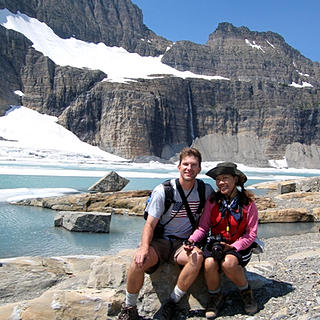Wait till our Neighbors find out...
- Admin - Aina Ferris
- Feb 16, 2021
- 4 min read
Updated: Jan 12, 2022
It's been a few years since the founding of The Native Explorer. Hundreds of followers and thousands of "likes" and "shares" later, we learned that Facebook will no longer feature the Story section of Pages such as ours. The following piece was originally written in Oct 2017, back when Brian and I were City of Overland NPC Commissioners. It's a story of how we began exploring local wildlife conservation through naturescaping. (Dedicated to Overland: A Great Place to Live)

Hello, neighbor. Allow us to introduce ourselves: Brian and Aina Ferris, founders of The Native Explorer homeowner education initiative. We are outdoor enthusiasts who have had the opportunity to explore some of nature’s wonders: From swimming with a playful pod of spinner dolphins in Hawaii, to marveling at the white cotton candy-like blossom of Montana’s towering bear grass, to staring wide-eyed at the Philippine tarsier, one of the world’s smallest Haplorrhini or "dry-nosed" primates.
Our adventures (and misadventures) whilst exploring this vast, blue planet are by no means unique. You are as much an explorer as us; and we share a common characteristic of mimicking nature’s beauty in our own back yard. As select members of the City of Overland’s Neighborhood Preservation Commission, we (the Commissioners led by Chairman Ken Crowder, that has nominated the city’s Homes of the Month over the last decade) have witnessed our neighbors simulate the great outdoors using tchotskes:

pink plastic flamingos, solar powered flower stakes, fountains, and animal sculptures. We have also visited homes that play host year-round to local wildlife by installing feeders, houses, ponds, baths, and an assortment of plants, shrubs and trees in their property.
Like many residents, Brian and I know that attractive landscaping increases the curb appeal of our property. We have gone beyond simply keeping the grass mowed and have tweaked our landscape design several times over the years. One day, Brian stumbled upon the term, “native plant” at an Earth Day celebration in Forest Park.

Why is it called a “native plant”? If there is such a thing as a native plant, then is there a “non-native”? Are native plants considered “good” and non-natives, “bad”? Thus began our exploration.
We are far from being experts on the subject of native gardening and landscaping. In order to learn, we meet and interact with horticulturists, master gardeners, online groups, and native plant experts and enthusiasts. Whatever insights we gather, we share for free to our community by way of social media, press releases, and non-profit talks hosted by The Native Explorer. We also learn and continue to study native plants through research and experimentation-- lots of experimentation. We have been members of the Missouri Botanical Garden, Wild Ones - St. Louis Chapter, and have had our property evaluated for certification by the very gracious Mitch Leachman himself, back when he led the St. Louis Audubon Society - Bring Conservation Home Community Partnership Program.


In 2018, we were fortunate to have gained the support of NPC Chairman Ken Crowder, Mayor Mike Schneider, Ritenour School District Superintendent Dr. Chris Kilbride, Wild Ones - STL Chapter, St. Louis Audubon Society - Bring Conservation Home, MO Wildflower Nursery, and Greenscape Gardens to produce a speaker series that was free of charge for the benefit of Overland residents.
Months after the event, those who provided The Native Explorer their contact details were invited in spring 2019 to take home some 150 native plant seedlings, mostly grown by Brian, at an event we held at the Overland Farmer's Market. Part of our goal that year was to help increase foot traffic to the market.
People sometimes ask me why The Native Explorer doesn't charge a dime for what we do. Our reward comes when it dawns on our neighbors that sustainability and conservation practices can be applied to and realized in their OWN yard.

Instead of colorful knickknacks, we want our neighbors to rely on gorgeous native Missouri perennials, annuals, shrubs, and trees to attract butterflies, bees, frogs, birds, and other local wildlife to their property.
We hope that by sharing what we learn via our website TheNativeExplorer.org, Facebook page, Instagram and Twitter posts, and through presentations and home garden consultations, that our homeowner education initiative can set strong roots in our community. Thanks for getting to know us, homeowners of St. Louis County. Now, it's time for St. Charles to...
Go Wild!
Brian and Aina Ferris
Call/Text: 314.598.7421
Website: TheNativeExplorer.org
Twitter: @ThePlantNerd_STL
Email: The.Native.Explorer@gmail.com
Facebook and Instagram: @Wildlings.of.StLouis

About the author:
Aina R. Ferris is a multi-platform content writer, designer, photographer, illustrator, and international award winning B2B marketing creative director. She is co-founder of the homeowner education initiative, The Native Explorer. Its mission is to promote wildlife conservation through thoughtful home landscaping (aka naturescaping) with plants native to one's home state. Aina serves as projects planner and communications lead. Her husband Brian Ferris, a certified sustainability associate, serves as plant researcher and lead gardener. The Native Explorer offers its services free of charge. For more information, visit their website: TheNativeExplorer.org. For the most current posts and updates, visit their The Native Explorer Facebook page: @Wildlings.of.StLouis. For inquiries, please email The.Native.Explorer@gmail.com.




Comments